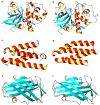Structural analysis of linear and conformational epitopes of allergens
- PMID: 19121639
- PMCID: PMC2716428
- DOI: 10.1016/j.yrtph.2008.11.007
Structural analysis of linear and conformational epitopes of allergens
Abstract
In many countries regulatory agencies have adopted safety guidelines, based on bioinformatics rules from the WHO/FAO and EFSA recommendations, to prevent potentially allergenic novel foods or agricultural products from reaching consumers. We created the Structural Database of Allergenic Proteins (SDAP, http://fermi.utmb.edu/SDAP/) to combine data that had previously been available only as flat files on Web pages or in the literature. SDAP was designed to be user friendly, to be of maximum use to regulatory agencies, clinicians, as well as to scientists interested in assessing the potential allergenic risk of a protein. We developed methods, unique to SDAP, to compare the physicochemical properties of discrete areas of allergenic proteins to known IgE epitopes. We developed a new similarity measure, the property distance (PD) value that can be used to detect related segments in allergens with clinical observed cross-reactivity. We have now expanded this work to obtain experimental validation of the PD index as a quantitative predictor of IgE cross-reactivity, by designing peptide variants with predetermined PD scores relative to known IgE epitopes. In complementary work we show how sequence motifs characteristic of allergenic proteins in protein families can be used as fingerprints for allergenicity.
Figures






Similar articles
-
Characteristic motifs for families of allergenic proteins.Mol Immunol. 2009 Feb;46(4):559-68. doi: 10.1016/j.molimm.2008.07.034. Epub 2008 Oct 31. Mol Immunol. 2009. PMID: 18951633 Free PMC article.
-
SDAP: database and computational tools for allergenic proteins.Nucleic Acids Res. 2003 Jan 1;31(1):359-62. doi: 10.1093/nar/gkg010. Nucleic Acids Res. 2003. PMID: 12520022 Free PMC article.
-
Data mining of sequences and 3D structures of allergenic proteins.Bioinformatics. 2002 Oct;18(10):1358-64. doi: 10.1093/bioinformatics/18.10.1358. Bioinformatics. 2002. PMID: 12376380
-
Bioinformatics approaches to classifying allergens and predicting cross-reactivity.Immunol Allergy Clin North Am. 2007 Feb;27(1):1-27. doi: 10.1016/j.iac.2006.11.005. Immunol Allergy Clin North Am. 2007. PMID: 17276876 Free PMC article. Review.
-
Evaluation of available IgE-binding epitope data and its utility in bioinformatics.Mol Nutr Food Res. 2006 Jul;50(7):638-44. doi: 10.1002/mnfr.200500276. Mol Nutr Food Res. 2006. PMID: 16764019 Review.
Cited by
-
Functional classification of protein toxins as a basis for bioinformatic screening.Sci Rep. 2017 Oct 24;7(1):13940. doi: 10.1038/s41598-017-13957-1. Sci Rep. 2017. PMID: 29066768 Free PMC article.
-
The importance of the 2S albumins for allergenicity and cross-reactivity of peanuts, tree nuts, and sesame seeds.J Allergy Clin Immunol. 2021 Apr;147(4):1154-1163. doi: 10.1016/j.jaci.2020.11.004. Epub 2020 Nov 18. J Allergy Clin Immunol. 2021. PMID: 33217410 Free PMC article. Review.
-
Food safety.Clin Rev Allergy Immunol. 2010 Oct;39(2):95-141. doi: 10.1007/s12016-009-8176-4. Clin Rev Allergy Immunol. 2010. PMID: 19911313 Review.
-
Distinguishing allergens from non-allergenic homologues using Physical-Chemical Property (PCP) motifs.Mol Immunol. 2018 Jul;99:1-8. doi: 10.1016/j.molimm.2018.03.022. Epub 2018 Apr 6. Mol Immunol. 2018. PMID: 29627609 Free PMC article.
-
Identification of critical amino acids in an immunodominant IgE epitope of Pen c 13, a major allergen from Penicillium citrinum.PLoS One. 2012;7(4):e34627. doi: 10.1371/journal.pone.0034627. Epub 2012 Apr 10. PLoS One. 2012. PMID: 22506037 Free PMC article.
References
-
- Asensio T, Crespo JF, Sanchez-Monge R, Lopez-Torrejon G, Somoza ML, Rodriguez J, Salcedo G. Novel plant pathogenesis-related protein family involved in food allergy. Journal of Allergy and Clinical Immunology. 2004;114:896–899. - PubMed
-
- Bindsley-Jensen C, Sten E, Earl LK, Crevel RWR, Bindslev-Jensen U, Hansen TK, Skov PS, Poulsen LK. Assessment of the potential allergenicity of ice structuring protein type III HPLC 12 using the FAO/WHO 2001 decision tree for novel foods. Food and Chemical Toxicology. 2003;41:81–87. - PubMed
-
- Bonds RS, Midoro-Horiuti T, Goldblum R. A structural basis for food allergy: the role of cross-reactivity. Current Opinion in Allergy and Clinical Immunology. 2008;8:82–86. - PubMed
Publication types
MeSH terms
Substances
Grants and funding
LinkOut - more resources
Full Text Sources

